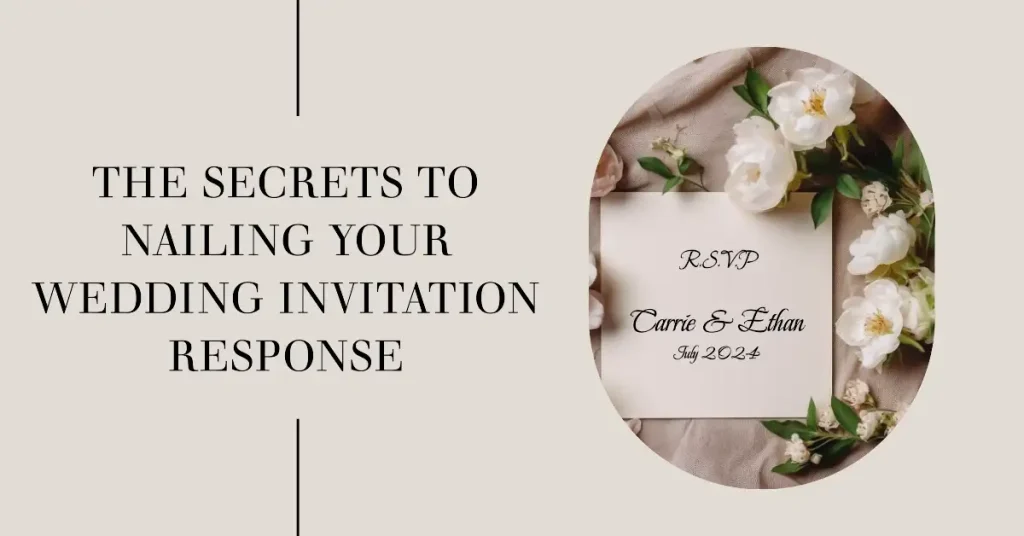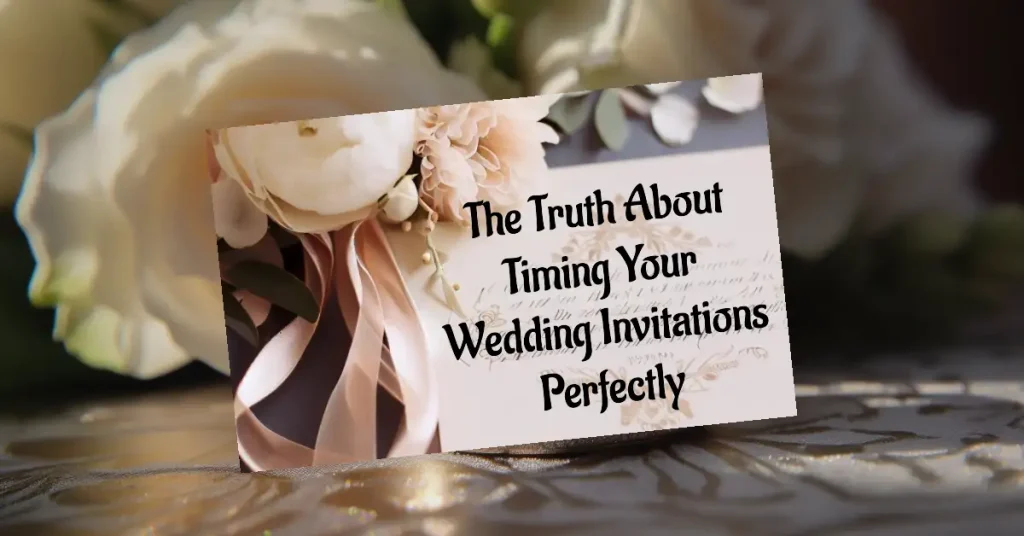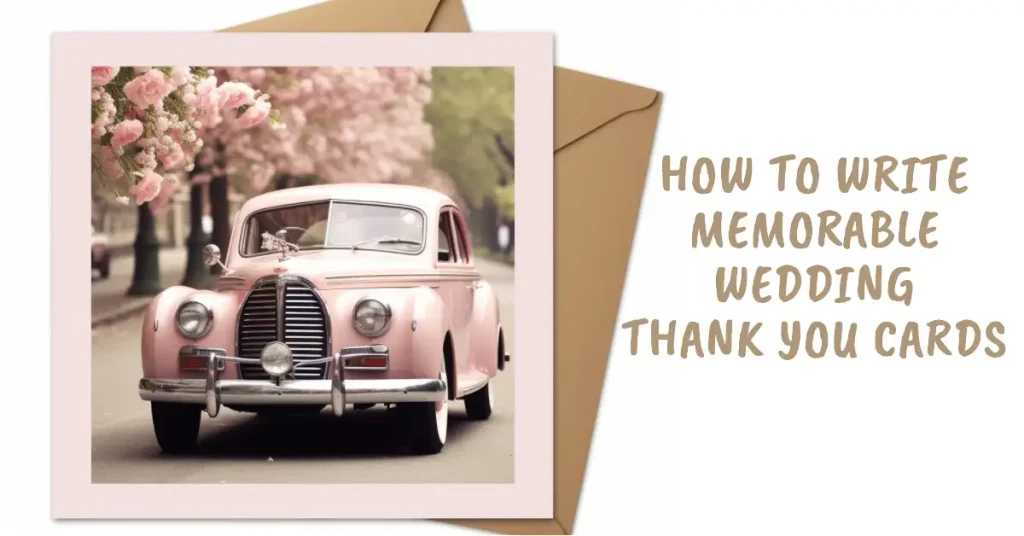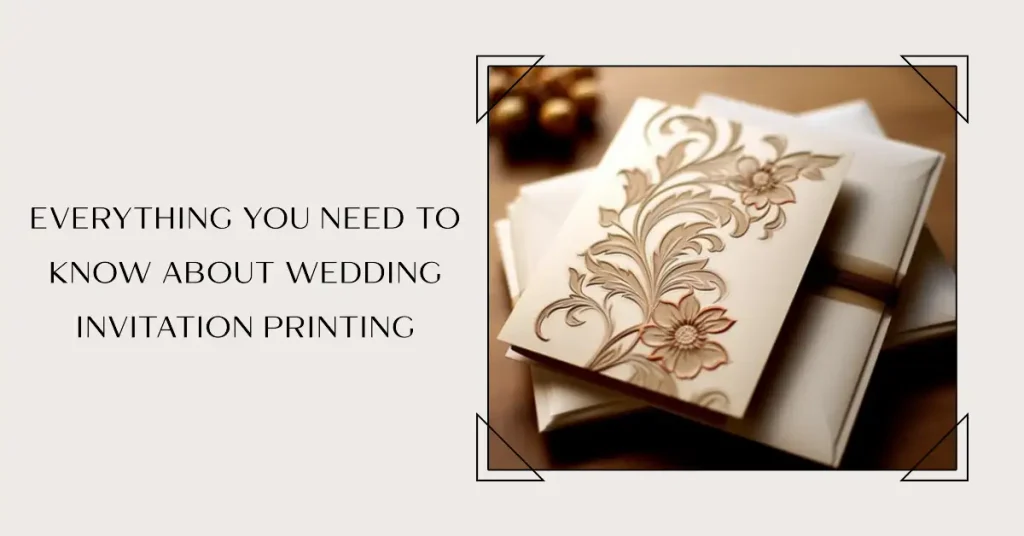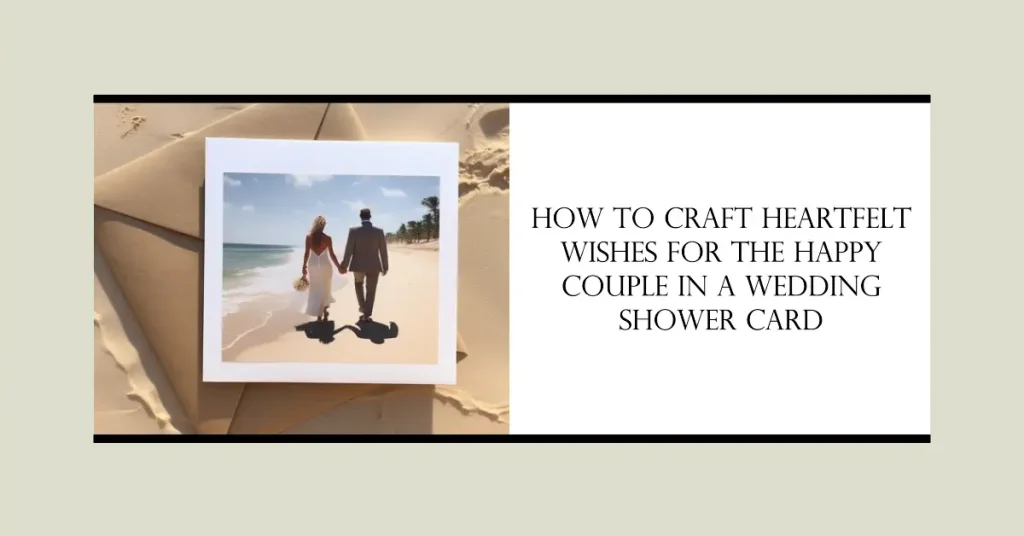Table of Contents
To fill out a wedding RSVP, carefully read the invitation for instructions and deadline, indicate your attendance, specify the number of guests, provide meal preferences or dietary restrictions if required, include your contact information, and return the RSVP through the specified method mentioned in the invitation. Double-check your response before sending it back.
We all know that flutter of excitement when we see a wedding invitation in our mailbox. But have you ever paused to consider the importance of that little RSVP card tucked inside? It’s not just a formality. Your response helps ensure a smooth planning process, making sure everything is perfect when the big day arrives.
Understanding Wedding RSVP Cards
Before we jump into the details of filling out an RSVP card, it’s important to appreciate why they’re such a crucial part of the wedding planning process. RSVP cards serve as a communication tool between the hosts—the couple getting married—and their guests. They offer a structured way to gather information that’s vital in planning the logistics of the wedding.
- Carter, Lisa (Author)
- English (Publication Language)
- 107 Pages - 04/06/2024 (Publication Date) - Independently published (Publisher)
At their core, RSVP cards ensure the couple knows who is coming to their wedding. This information influences numerous aspects of the wedding planning, from the size of the venue to the number of meals to order. It affects seating arrangements, costs, even the size of the dance floor. Without accurate RSVPs, the couple could face unnecessary stress and unexpected expenses.
An RSVP card typically asks for a few key pieces of information. First and foremost, your name. This might seem obvious, but it’s crucial to write your name exactly as it appears on the envelope. This ensures there’s no confusion about who’s replying. If your family is included on the invitation, make sure to indicate which members will be attending.
Next, the card will ask you to state whether you’re attending the wedding or not. This is usually done through a simple checkbox or a selection to indicate ‘accepts with pleasure’ or ‘declines with regret’.
Sometimes, RSVP cards may also ask for your meal preference. This is common for weddings where a sit-down dinner is served. The options usually include meat, fish, or a vegetarian dish. If you have any dietary restrictions or allergies, it’s a good idea to mention these as well.
RSVP cards can be as diverse and unique as the weddings they’re used for. Traditional cards often use formal language and may include stamped return envelopes for convenience. Modern cards, on the other hand, may use more casual language, unique designs, or even digital formats. Some couples incorporate their wedding theme or personal touches into the RSVP cards, making them a memorable keepsake for guests.

RSVP Card Language and What It Means
RSVP cards, especially traditional ones, often come adorned with specific phrases and terminology that can be a bit puzzling if you’re not familiar with them. The language used is usually formal and carries a certain etiquette that’s been passed down through generations.
First and foremost, the term “RSVP” itself is an acronym for the French phrase “Répondez s’il vous plaît,” which translates to “Please respond.” This is a polite request from the couple for you to let them know whether or not you’ll be attending their wedding.
Often, you’ll find the choices of “accepts with pleasure” and “declines with regret” on an RSVP card. These are just formal and polite ways of saying yes or no to the invitation. If you’re attending, you’d check “accepts with pleasure”, and if you can’t make it, you’d select “declines with regret.”
When it comes to meal choices, you might see terms like “beef,” “chicken,” “fish,” or “vegetarian” – these are straightforward, indicating the type of main course. If you see “chef’s choice” or “seasonal selection,” it means the chef will prepare a special dish based on what’s in season or their specialty.
The phrase “number attending” or “number of guests” is asking you to write down how many people in your party will be coming. This is particularly important if the invitation was extended to your entire family or included a plus one.
Sometimes, you’ll see “M” followed by a blank line at the start of the card. This is a formal way of providing a space for you to write your title (Mr., Mrs., Ms., Dr., etc.) and your full name.
Understanding the language on an RSVP card is key to filling it out correctly. Despite the formal phrases, it all comes down to the couple wanting to know who will be there to share in their special day.
The Etiquette of Responding to Wedding Invitations
Receiving a wedding invitation is an honor—it means the couple sees you as an important part of their lives and they want you there on their special day. With this honor comes a bit of responsibility, especially when it comes to the etiquette of responding to the invitation.
First and foremost, it’s important to respond as soon as you can. While it’s tempting to put the RSVP card on your refrigerator as a reminder or keep the lovely invitation on display, it’s best not to delay your response. Most couples will include an RSVP deadline on the invitation, and it’s crucial to respect this. If there’s no deadline given, a good rule of thumb is to respond within two weeks of receiving the invitation.
The promptness of your response isn’t just about courtesy—it has practical implications for the couple’s wedding planning process. They need to finalize their guest list, catering order, seating plan, and more. A timely RSVP can alleviate some of their stress, letting them know they can count on your presence or plan around your absence.
When filling out the RSVP card, it’s important to be clear and precise. Ensure your name matches the one on the invitation and clearly state whether you’re attending. If meal choices are included, indicate your preference. If you’re unable to attend, it’s thoughtful to include a brief note expressing your regret and well wishes for the couple.
It’s also important to respect the invitation as it’s presented. If your invitation doesn’t indicate a plus one, it’s a faux pas to ask to bring a guest. Likewise, if your children’s names aren’t on the invitation, it’s usually a sign they’re not invited. If you’re unsure, it’s best to reach out to the couple or the wedding planner for clarification.
RSVPs and Wedding Etiquette for the Modern Age
As with many aspects of our lives, technology and changing social norms have influenced the world of weddings and the etiquette surrounding RSVPs. In the modern age, we see new trends and practices emerging that reflect our evolving lifestyles.
One of the most noticeable changes is the rise of digital RSVPs. More and more couples are choosing to send invitations electronically and ask guests to respond in the same way. This can be through a wedding website, email, or even a dedicated app. While this may seem less formal, it’s a practical response to our increasingly digital lifestyles and can make the process easier for both the couple and their guests. However, the same rules of promptly and clearly responding still apply.
The language used in modern RSVPs can also be more relaxed and personalized. Instead of the traditional ‘accepts with pleasure’ and ‘declines with regret,’ you might see more casual, fun, and creative language that reflects the couple’s personality. That said, it’s essential to still treat the process with respect and respond in a timely and considerate manner.
Another notable change is the shift towards inclusivity in modern weddings. This can affect the guest list and the RSVP process. For instance, plus one etiquette has evolved, with many couples now including clear instructions about plus ones on the invitation. The same goes for children at weddings—modern couples often specify whether kids are welcome or if the event is adults-only.
In the modern age, it’s also become more common to see dietary preferences or restrictions included in the RSVP process, reflecting growing awareness and respect for diverse dietary needs. You might be asked to indicate if you’re vegetarian, vegan, gluten-free, or have certain allergies.
While wedding RSVP etiquette has evolved, the fundamental principles of respect, promptness, and clear communication remain. Whether you’re responding to a traditional invitation or a digital one, these guidelines will help you navigate the process with grace and consideration.
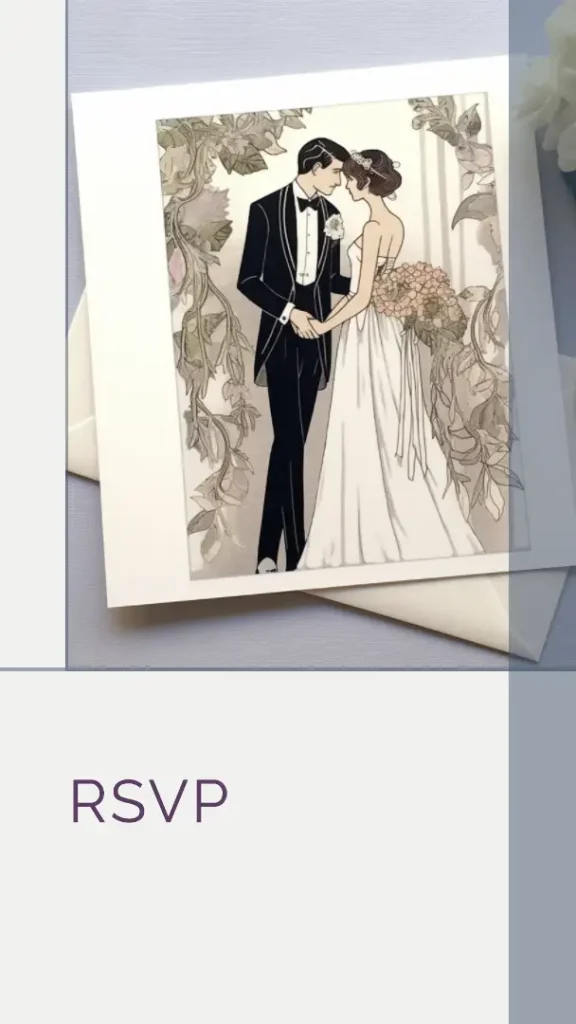
RSVPing for Different Types of Weddings
While the primary purpose of an RSVP remains consistent—to let the couple know if you’ll be attending their wedding—the specifics can vary depending on the type of wedding. Let’s explore some of these variations:
For a traditional wedding, the RSVP process tends to be quite formal. They may also include options to RSVP for additional events like a rehearsal dinner or a post-wedding brunch.
Destination weddings present their own unique set of circumstances. The RSVP deadline is usually earlier to accommodate travel arrangements. You might also find questions related to travel or accommodation preferences on the RSVP card. For example, you may be asked if you’re staying at the suggested hotel or need transportation to and from the venue.
When it comes to themed weddings, the RSVP card might include extra sections related to the theme. If it’s a costume party, for instance, you might be asked to describe your costume. Or, for a fandom-themed wedding, there may be a place for you to share your favorite quote or character.
Micro weddings, which are smaller, more intimate events, often allow for more personalized RSVP cards. You might be asked to request a song for the dance floor or to share a memory or advice for the couple. These responses can add a personal touch to the event, making it even more special for both the couple and the guests.
What to Do if Plans Change
While we all hope to commit to our RSVP, life can sometimes throw a curveball, and plans might need to change. If you find yourself in a position where your initial RSVP response needs to be altered, there’s a right way to handle it.
Firstly, remember the golden rule of wedding etiquette: communicate. If you initially accepted the invitation but can no longer attend, it’s essential to let the couple or the wedding planner know as soon as possible. Don’t just assume they’ll figure it out when you don’t show up; this can lead to confusion and added stress on the wedding day.
When communicating about a change in your RSVP, be clear, direct, and apologetic. Whether you contact them by phone, email, or through a handwritten note, express your regret and provide a brief explanation. Remember, you don’t owe them a detailed account of your personal circumstances, but a simple explanation can help them understand the situation.
On the other hand, if you initially declined but your circumstances have changed allowing you to attend, reach out as soon as you can. However, bear in mind that it may not be possible to accommodate you, especially if your change of heart happens close to the wedding day. In this case, be understanding and gracious, regardless of whether they can adjust their plans for you.
In both cases, it’s always a nice gesture to send a gift with a thoughtful note, expressing your best wishes for the couple. This shows your respect and appreciation, even if you can’t be physically present at their celebration.
Conclusion: How to Fill out Wedding RSVP
RSVPs play an essential role in making a wedding successful. They’re more than just a piece of card or a digital form—they represent a mutual respect between the guests and the hosts. So next time you receive an invitation, remember the difference your prompt and accurate response can make.
FAQs
Q: Do I need to provide my contact information on the RSVP?
A: Yes, it is essential to provide your full name and contact information (phone number, email address) on the RSVP card or in the designated response area. This allows the couple to reach out to you if needed.
Q: What should I do if I made a mistake when filling out my RSVP?
A: If you made a mistake on your RSVP, such as indicating the wrong attendance status or misspelling names, contact the couple or the designated RSVP contact provided on the invitation. They will guide you on how to rectify the error.
Q: How should I return the RSVP?
A: Follow the instructions mentioned in the invitation regarding the preferred method of response. This could be mailing back the RSVP card, responding via email or phone, or using an online RSVP platform or wedding website if provided.
Q: Is it necessary to double-check my RSVP before sending it?
A: Absolutely! Double-checking your RSVP before sending it ensures that you have filled out all the required fields accurately. Verify your attendance, guest count, meal preferences, and contact information to avoid any mistakes.
Q: What if I miss the RSVP deadline?
A: It is best to respond before the RSVP deadline. However, if you miss it, contact the couple immediately to apologize and inquire if they can accommodate your late response. Respect their decision if they are unable to do so.
Q: What if I haven’t received an RSVP card with the invitation?
A: If you did not receive an RSVP card with the invitation, check if the couple has provided alternative ways to respond, such as through email or a wedding website. If not, reach out to them directly to inquire about the preferred method of RSVP.
Q: Should I fill out an RSVP for each individual in my household separately?
A: Typically, you should RSVP for each individual separately if their names are specified on the invitation. This allows the couple to accurately track the number of attendees and plan accordingly.
Q: Can I bring someone not mentioned on the invitation as my guest?
A: It is generally considered polite to adhere to the guest names specified on the invitation. If you would like to bring an additional guest, contact the couple beforehand to inquire if it would be possible.
Q: What if I have not yet decided whether I can attend or not?
A: If you are uncertain about your attendance at the time of receiving the invitation, it is still important to respond promptly. Indicate that you are undecided or need more time to decide and inform the couple as soon as you have made your final decision.
Q: Is it acceptable to decline an invitation?
A: Yes, it is perfectly acceptable to decline a wedding invitation if you are unable to attend. Respond with a polite and appreciative message, expressing your regrets and thanking the couple for inviting you.
Q: Can I fill out an RSVP for additional events surrounding the wedding, such as a rehearsal dinner?
A: The invitation should specify which events require a separate RSVP. If there are other events for which you need to respond, make sure to follow the instructions provided and indicate your attendance or regrets accordingly.
Q: What if I have special accommodations or accessibility needs?
A: If you have any special accommodations or accessibility needs, it is important to communicate them to the couple. Reach out to them directly or include a note with your RSVP, detailing your requirements, so they can make necessary arrangements.
Q: Should I send a gift even if I am unable to attend the wedding?
A: Sending a gift is not mandatory if you are unable to attend the wedding, but it is a thoughtful gesture to show your support and congratulations to the couple. Consider sending a gift or a card to express your well wishes even if you cannot be there in person.
Q: How long should I wait for a response to my RSVP?
A: It is common for couples to receive a large number of RSVPs, so it may take some time for them to process and confirm attendance. If you haven’t received a response after a reasonable period, feel free to follow up with the couple to ensure your RSVP was received.
Key Takeaways
- Read the invitation carefully: Pay attention to instructions, deadlines, and any specific information provided.
- Provide your name and indicate attendance: Write your name exactly as it appears on the envelope and check the appropriate box to accept or decline the invitation.
- Specify the number of guests: If the invitation includes your family or a plus one, indicate the number of people attending.
- Meal preferences or dietary restrictions: If asked, indicate your meal preference (meat, fish, vegetarian, etc.) and mention any dietary restrictions or allergies.
- Include contact information: Provide your full name, phone number, and email address so the couple can reach you if needed.
- Return the RSVP as instructed: Follow the specified method mentioned in the invitation, such as mailing back the RSVP card, responding via email or phone, or using an online RSVP platform.
- Double-check your response: Review your RSVP before sending it to ensure accuracy in attendance, guest count, meal preferences, and contact information.
- Respond promptly: Respect the RSVP deadline or respond within two weeks of receiving the invitation to help the couple with their planning process.
- Adhere to invitation details: Respect the invitation as presented, including the specified guest names and whether children or plus ones are included.
- Modern RSVP trends: Digital RSVPs are becoming more common, with couples using wedding websites, email, or dedicated apps. Language and design on RSVP cards may also reflect the couple’s personality and theme.
- Communicate changes in RSVP: If plans change, inform the couple as soon as possible with a clear and direct message, expressing your regret and providing a brief explanation.
- Send a gift if unable to attend: While not mandatory, it is a thoughtful gesture to send a gift and a congratulatory note to the couple even if you cannot attend.
COPYRIGHT NOTICE
Please be advised that all images, designs, and creative content on this page are the exclusive property of TheIDoGuide.com and are protected under international copyright laws. The images may not be reproduced, copied, transmitted or manipulated without the written permission of TheIDoGuide.com.
Unauthorized use, distribution, display, or creation of derivative works of any images contained on this site, is strictly prohibited and can lead to legal penalties. We actively monitor for, and enforce, our copyright interests.
If you wish to use any of our images, kindly contact us to seek permission. Respect of copyright is not merely a legal requirement but also an acknowledgement and support of the hard work and creativity that goes into producing them.
Thank you for your understanding and cooperation.
© 2023, TheIDoGuide.com. All Rights Reserved.

